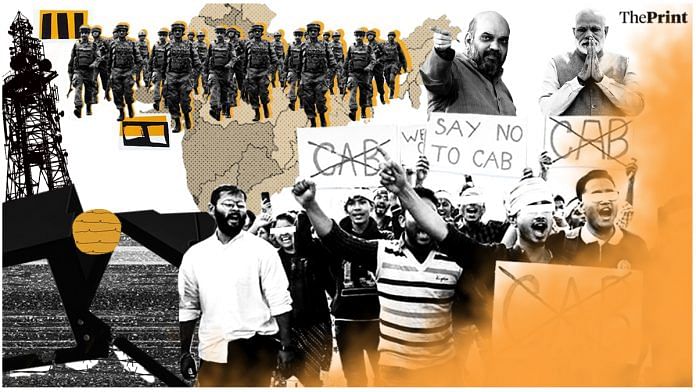As protests rage in Assam against Modi government’s Citizenship (Amendment) Bill, the Information and Broadcasting Ministry notified TV news channels Wednesday to not broadcast content that is “likely to encourage or incite violence…”. The Nanavati Commission’s report on the 2002 Gujarat carnage, released Wednesday, also recommended restrictions on media coverage during communal riots.
ThePrint asks: Godhra, Kashmir, northeast CAB unrest: can clampdowns on media visuals help curb violence?
Indian media today can incite violence and inflame passions
 Sushant Sareen
Sushant Sareen
Senior fellow, ORF
The media can incite violence and flame passions. At one level, it has become more raucous than ever before in India. It’s a no-holds-barred media, which is always in your face.
Earlier, the debates were restrained. Whenever there was a conflict or a riot, the media would never name the communities involved. That kind of restraint is gone now.
But the tricky question that arises is whether a government diktat can tell the media how to report. Or should the gatekeepers of media exercise responsibility and restraint?
During the old media days, there was the luxury of bringing the paper out the next day. But today, it is about instant gratification. Everyone wants to be the first to report a piece of news without verifying it. The media too broadcasts unverified news, and fake news ends up getting a life of its own. Rumours are always floating around and people start building theories around what was a rumour at best and fake news at worst.
An advisory issued is not a diktat. It’s a statement that caution needs to be exercised, I think it would be a problem if the Modi government censors news organisations. But I don’t think that is the case. Moreover, the recommendations for media restrictions in the Nanavati Commission report are merely observations.
The Gujarat coverage led to international agencies and public opinion turning against the state government
 R. B. Sreekumar
R. B. Sreekumar
Former IPS officer
Imposing media blackout must be decided on the basis of what content news channels are broadcasting and what they are projecting. During the 2002 Gujarat riots, I sent reports to then-Chief Minister Narendra Modi’s government about the ground situation, but no official responded. Ultimately, they punished me for these reports.
A barrage of fabricated news stories were being circulated at that time. Reports of Hindu women being molested and their ‘chests’ being cut and thrown away were surfacing. But after five days or so, our inquiry found that it wasn’t true.
On the other hand, the ghastly and gruesome scenes of violence being reported helped give an idea of what was happening on the ground. This coverage led to international agencies and public opinion turning against the state government. Those grisly visuals showed that truth cannot be suppressed.
In the context of Godhra, I think that it was politically very motivated to project and display the Hindu dead bodies. This was covered by the news media, which may have instigated violence.
What the government learned in Kashmir, it will apply in Assam and Chhattisgarh too
 Khurram Parvez
Khurram Parvez
Human rights advocate
History is proof that Indian journalists have accepted the version of the Indian government’s stand on the Kashmir issue. So, why should they get to complain now? What holds true for Indian journalists on Kashmir is exactly what will happen in other parts of the country. Martin Luther King once said, “Injustice anywhere is a threat to justice everywhere.”
Unfortunately, most of the print media and the digital media platforms have completely accepted the Indian logic on Kashmir — their coverage of this issue speaks for itself. Restrictions on the media started many years ago, now it is only natural that the Modi government expects the media to toe the party line on other issues as well.
In the last few years, media organisations and civil society went to the extent of calling the Indian government’s actions in Kashmir as ‘reasonable restrictions. Unfortunately, Kashmir has been the laboratory of violence for the government of India. Whatever the government is learning and applying in Jammu and Kashmir, it will implement the same in Assam, Chhattisgarh and other conflict zones.
Journalists are now concerned that they will be subjected to the same treatment. It is very hypocritical not on the part of the government but on the part of the media to be questioning restrictions on it only now.
Carnage is best reported without visuals. And with sober commentary, not shrieking reporters & anchors
 Sevanti Ninan
Sevanti Ninan
Media commentator and columnist
There is no doubt that visuals of riots can be provocative. The tenor of news coverage also matters, and this is shaped by how newspapers and TV channels in both Assam today and Gujarat then reflected the ideology of their owners in some cases. TV advisories in times of conflict certainly need to be enforced. Carnage is best reported without visuals. And accompanied by sober commentary, not shrieking reporters and anchors.
But to say, as the Nanavati Commission report does, the communal violence in Gujarat was inflamed because of the wide publicity given by the media to the Godhra incident and the events that followed is to ignore the other kinds of incitement that took place during the 2002 riots.
In the case of Kashmir, I don’t know how widely the violence inflicted by both sides is shown when the conflict here is covered in visual media. If you are showing violent protestors, you also need to show the pellet attacks by security forces for people in the rest of the country to get a fair idea of what the people of the state are up against. And if you show neither, the situation in Kashmir stays out of mind for people outside the union territory. Which too is a tragedy.
Media is playing a positive role in Assam. TV channels ran messages on screen saying ‘we don’t condone violence’
 Aman Wadud
Aman Wadud
Lawyer, Gauhati High Court
I don’t see an element of violence in Assam protests. The only violence that has been witnessed is the police brutality on agitators. People have doubts that a third party may have entered the agitation just to make the demonstrations look violent.
The ongoing Assam protests are organic. Women, old people, children and students are participating in the protests. Do you think these people can participate in violence? There is no one person leading these protests, it’s a collective effort.
There are definitely some elements that may trigger violence. But I don’t see how a government circular on media limitations will help prevent the same.
The media has played a positive role, especially in the case of Assam. News channels carry advisories at the bottom claiming “we don’t condone violence” and some are even requesting people to peacefully demonstrate. The protestors themselves claim that they want to follow the path of non-violence propagated by Gandhi. They will be sitting on hunger strikes soon. So, it can’t be said that news channels are propagating violence.
Also read: CAB protests a battle for India – either we are a secular state or we aren’t India at all
By Kairvy Grewal, journalist at ThePrint




The media has a duty and a right to report the truth. Evidently with sensitivity and discernment. It is no part of its job – Prasar Bharati was created for that purpose – to act as a hands maiden to those in power. If the visuals are hurtful, think through the likely / logical consequences of your actions. The fact that Gauhati’s Commissioner of Police had to be changed within a day, an IPS officer is being deputed from Delhi to the state suggests almost a panic response. 2. It is the 24 / 7 job of the security establishment to assess how people will respond to unfolding events, brief their masters in good time. They should not only be permitted, they should be enjoined to be candid, even blunt, in their presentations. CAB has been through a dry run in January, the views and sentiments of the north east were manifest. 3. One way or another, as the query posed in this column subliminally suggests, the alibi is that the bad news is all the messenger’s fault.